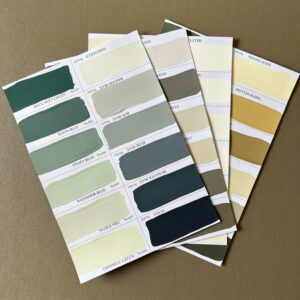Related colours
£3.99 – £57.60
£3.99 – £57.60
£3.99 – £57.60
£3.99 – £57.60
£3.99 – £57.60
Technical
Theoretical: 14 sq meters per liter
Recommended: 10 sq meters per liter
Time to re-coat: 1-2 hours
Fully Dry: 4.6 hours
2 Coats minimum
3 Coats for deep colours yellows and reds 1-2 Coats of white primer if changing from another deep colour
EU limit for this product (cat A/a:30 grams per litre (2010). This product contains 0.3-7% (depending on colour) which is classified as low VOC.
Matt Emulsion: Volume solids 34-40% depending on colour. Gloss level is less than 1% (100% = full gloss).
Eggshell: Volume solids 34-40% depending on colour. Gloss level 15-20% (100% = full gloss).
At recycling centre
Substrate must be clean, dry and dust free. Prime bare plaster with a coat of paint that has been thinned 20% with water (1 litre of water to 4 litres of paint), or use ‘contract’ emulsion which is designed to go onto bare plaster. Bare plaster must be properly dry before painting. Previously painted walls should be cleaned with sugar soap and lightly abraded. This is especially important if you are painting onto a ‘shiny’ surface such as Vinyl Silk or Eggshell. Any cracks or holes should be filled, sanded and then primed with a thinned coat of paint.
New soft wood, should be primed with a water borne acrylic primer. Knots in softwood should be sealed with a knotting solution. Hard woods can be difficult to paint as some types are very oily. We recommend you take advice from your paint supplier or a professional decorator. Acrylic eggshell can be applied direct to previously painted woodwork but it must be clean and sanded to give a key. If it is a big colour change then it is better to use a white primer to obliterate the previous colour.
Do not use when temperature is below 5 C (paint may be damaged by first and will be slow to dry) or above 30 C (paint will dry too quickly).
Stir thoroughly before use and make sure you are happy with colour.
Brush application is fine for small areas and we recommend that you use a good quality synthetic brush (Purdy or similar). When using a brush to paint large areas there is a risk of the paint drying too quickly and you may get an uneven finish. Our eggshell looks thick in the can but can be applied un thinned by brush. It has good ‘hold up’ qualities and does not sag.
Roller application is best for most surfaces. We normally recommend a short pile sleeve for woodwork (4 inch or 7 inch) or a medium pile 7or 9 inch sleeve for walls. On woodwork (doors, panelling) we suggest that you follow the roller with a brush to lightly remove any air bubbles or irregularities in the roller applied paint.
Eggshells do not dry as quickly as matt emulsions because they have a higher resin content. Even so, when painting walls or any large area do not go over areas that have already started to dry as you may get ‘flashing’ and an uneven finish. For best results we recommend that you cut in around the edges with a brush and then roll, rather than the other way round.
Spray – airless spray, thin up to 20% and use a 511- 513 tip. Conventional, thin up to 40% and use a 1.6-1.8 mm tip.
Clean up using water. Do not tip paint down drain. Dispose of old paint responsibly.
Store all paints in a cool dry place. Protect from frost. New, unopened paint should be used within 12 months of purchase. Once opened, make sure lid is secure and use as quickly as possible. Water borne paints that has been kept for more than 12 months can be subject to microbial attack that ‘eats’ the resin. Make sure that paint from an old tin is ok before using it again.
Old paint must be disposed of in accordance with local regulations. There are normally disposal points at local recycling centres.









